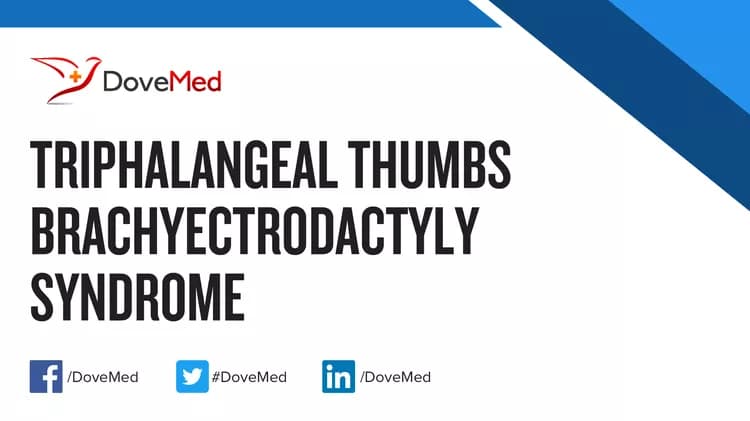What are the other Names for this Condition? (Also known as/Synonyms)
- Triphalangeal Thumb and Brachyectrodactyly Syndrome
- Triphalangeal Thumb and Brachy-Ectrodactyly Syndrome
What is Triphalangeal Thumbs Brachyectrodactyly Syndrome? (Definition/Background Information)
- Triphalangeal Thumbs-Brachyectrodactyly Syndrome is characterised by triphalangeal thumbs and brachydactyly of the hands
- It has been described in four families and in one isolated case
- Ectrodactyly of the feet and, more rarely, ectrodactyly of the hands were also reported in some family members
- The transmission of Triphalangeal Thumbs-Brachyectrodactyly Syndrome is autosomal dominant
(Source: Triphalangeal Thumbs Brachyectrodactyly; Orphanet, National Institute of Health and Medical Research (INSERM), Paris.)
Who gets Triphalangeal Thumbs Brachyectrodactyly Syndrome? (Age and Sex Distribution)
- Triphalangeal Thumbs-Brachyectrodactyly Syndrome is a rare congenital disorder, reported in less than 10 individuals in the medical literature
- The presentation of symptoms may occur at birth or in infancy
- Both males and females may be affected
What are the Risk Factors for Triphalangeal Thumbs Brachyectrodactyly Syndrome? (Predisposing Factors)
- A positive family history may be an important risk factor, since Triphalangeal Thumbs-Brachyectrodactyly Syndrome can be inherited
- Currently, no other risk factors have been clearly identified for this syndrome
It is important to note that having a risk factor does not mean that one will get the condition. A risk factor increases one’s chances of getting a condition compared to an individual without the risk factors. Some risk factors are more important than others.
Also, not having a risk factor does not mean that an individual will not get the condition. It is always important to discuss the effect of risk factors with your healthcare provider.
What are the Causes of Triphalangeal Thumbs Brachyectrodactyly Syndrome? (Etiology)
- The genetic cause of Triphalangeal Thumbs-Brachyectrodactyly Syndrome is not known at the present time
- The condition is reportedly inherited in an autosomal dominant manner
Autosomal dominant inheritance: Autosomal dominant conditions are traits or disorders that are present when only one copy of the mutation is inherited on a non-sex chromosome. In these types of conditions, the individual has one normal copy and one mutant copy of the gene. The abnormal gene dominates, masking the effects of the correctly function gene. If an individual has an autosomal dominant condition, the chance of passing the abnormal gene on to their offspring is 50%. Children, who do not inherit the abnormal gene, will not develop the condition or pass it on to their offspring.
What are the Signs and Symptoms of Triphalangeal Thumbs Brachyectrodactyly Syndrome?
The signs and symptoms of Triphalangeal Thumbs-Brachyectrodactyly Syndrome may include:
- Short 2nd finger
- Short 3rd toe
- Split foot
- Split hand
- Triphalangeal thumb
(Source: Triphalangeal Thumbs Brachyectrodactyly; Genetic and Rare Disease Information Center (GARD) of National Center for Advancing Translational Science (NCATS), USA.)
How is Triphalangeal Thumbs Brachyectrodactyly Syndrome Diagnosed?
Triphalangeal Thumbs-Brachyectrodactyly Syndrome is diagnosed on the basis of the following information:
- Complete physical examination
- Thorough medical history evaluation
- Assessment of signs and symptoms
- Laboratory tests
- Imaging studies
- Biopsy studies, if necessary
Many clinical conditions may have similar signs and symptoms. Your healthcare provider may perform additional tests to rule out other clinical conditions to arrive at a definitive diagnosis.
What are the possible Complications of Triphalangeal Thumbs Brachyectrodactyly Syndrome?
The complications of Triphalangeal Thumbs-Brachyectrodactyly Syndrome may include:
- Weak grip strength
- Difficulty lifting or holding objects
Complications may occur with or without treatment, and in some cases, due to treatment also.
How is Triphalangeal Thumbs Brachyectrodactyly Syndrome Treated?
There is no cure for Triphalangeal Thumbs-Brachyectrodactyly Syndrome, since it is a genetic condition. The treatment is usually given to manage the signs and symptoms and any complication that develops.
How can Triphalangeal Thumbs Brachyectrodactyly Syndrome be Prevented?
Triphalangeal Thumbs-Brachyectrodactyly Syndrome may not be preventable, since it is a genetic disorder.
- If there is a family history of the condition, then genetic counseling will help assess risks, before planning for a child
- Active research is currently being performed to explore the possibilities for treatment and prevention of inherited and acquired genetic disorders
Regular medical screening at periodic intervals with tests and physical examinations are recommended.
What is the Prognosis of Triphalangeal Thumbs Brachyectrodactyly Syndrome? (Outcomes/Resolutions)
- The prognosis of Triphalangeal Thumbs-Brachyectrodactyly Syndrome is dependent upon the severity of the signs and symptoms and associated complications, if any
- The condition is not life-threatening and the lifespan of affected individuals is reportedly normal
Additional and Relevant Useful Information for Triphalangeal Thumbs Brachyectrodactyly Syndrome:
The following DoveMed website link is a useful resource for additional information:
Related Articles
Test Your Knowledge
Asked by users
Related Centers
Related Specialties
Related Physicians
Related Procedures
Related Resources
Join DoveHubs
and connect with fellow professionals


0 Comments
Please log in to post a comment.